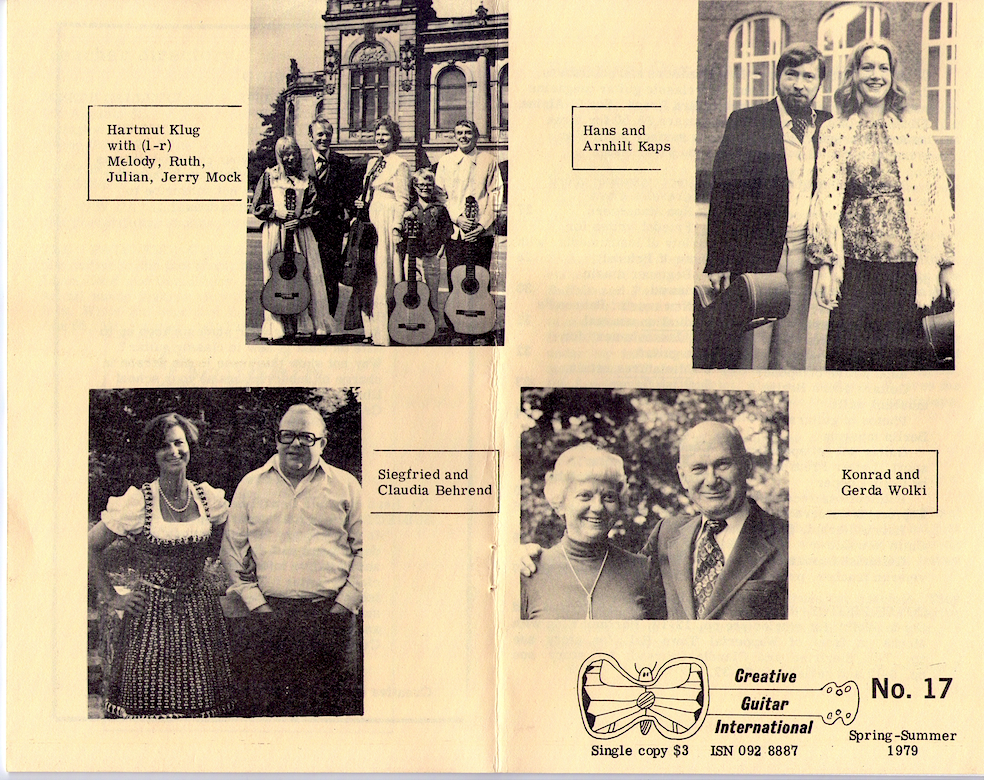
|
|
||
 |
||
|
|
||
Content highlights:
Interview with Gilbert Biberian
Guitar in Wuppertal
Workshop with Siegfried Behrend in Bavaria
List of guitar choir music
Hansjoachim Kaps, composer
Guitar not yet spectator sport - Colin Cooper
Nels Leonard
Kurt-Joachim Friedel, composer
New music for guitar reviewed
|
|
||||||
|
© 1979 by Ruth and Jerry Mock, editors and publishers, Creative Guitar International is a classic guitar magazine published irregularly by Mockingbird Press, Box X, Alpine, TX 79830, USA. Subscription rates are $8.50 for three issues. Overseas subscriptions by surface mail. For overseas air mail subscription, add $2 an issue.
|
||||||
|
This is the second and final part of an interview with Gilbert Biberian about the Toronto Guitar Festival (for Part 1, see CGI No. 16, pp. 11-15). The interview was conducted in September 1978 at Biberian's London apartment. Here Biberian talks about the requinto and other guitars, the type of music guitarists play, their training, and his own music:
Q. What kind of ensembles did you have in your classes?
A. The crop of people we had was wonderful. Committed, enthusiastic, eager to learn. We had duos and quartets: the Buffalo and Peabody quartets and I haven't stopped praising these two. They are fantastic. I was very pleasantly surprised to see the work that I had started 10 years ago had come to fruition almost independently of me, but now also coming under my influence. I am training the first generation of quartetists. There is a quartet in London just starting out, the London Guitar Quartet, also my students. It gives me agreat sense of satisfaction to be able to train these groups, although we had very little time.
Q. Did either one of these use the requinto?
A. Not yet, but they will be doing so.
Q. Different instruments ?
A. The Peabody had a seven-string guitar. A brilliant idea. We of the Omega have thought of doing this but just haven't got around to it. It's only now that we are having new requintos made, let alone extending our basses, but we are going to get around to that.
I didn't have enough praise for these two quartets. They were extremely good musicians. Their ensemble playing was immaculate; it was really astounding. We are going to exchange repertoires.
Q. Would you like to mention the sound of the requinto?
|
||||||
|
Biberian: Our generation's turn 3
Klug patient director 7
Photos of Wuppertal group and town hall concert 8
Bavarian workshop performance 9
Drawing by Behrend 12
Annotated list of guitar choir music 12
|
Improvisation: chord progression given by Ron Manzanero 27
Friedel writes for variety of instruments, with
|
|||||
|
|
photo of Friedel 28
Beginner music reviewed 30
New music: Behrend's Meditation unusual 31
"Jesse James" for solo guitar 32
Miniatures retain Scottish flavor 33
Latin rhythms in a contemporary setting 34
Altered Giuliani Concerto, unaltered 34
Rags for guitar; Finnish pieces; sketches of Segovia 35
Wade records pieces 36
Computer search by Frank Wagner 36
Want ads, teacher directory, Dauphinaisad 37
|
|||||
|
|
Photo of Gerda Wolki with Berliner Lautengilde 16 Kaps active composer 17
Guitars adorn Berlin museum walls 19
Photos of guitars in Berlin museum 20
Guitar not yet spectator sport, Letter From London by Colin Cooper 22
Publications received: Zupf musik -Gitarre 23
Harris Herald, Guitar Guild Newsletter 24
Guitarist Leonard veteran teacher, professor 25
|
|||||
|
COVER PHOTOS--Hans and Arnhilt Kaps; and Konrad and Gerda Wölki: for stories see pp. 12-19. Hartmut Klug with Mocks in front of Wuppertal Town Hall; for story see pp. 7-9. Siegfried and Claudia Behrend; for story see pp. 9-12 and review pp. 31-32. |
||||||
|
3
|
||||||
|
|
||||||
|
|
|||
|
Segovia has been quoted as saying the requinto sounds very squeaky.
A. We think the requinto is very good and that most quartets will agree with that once they start using it; they will say it is fantastic.
Any remarks that Maestro Segovia, or any other maestro might make, ought to be taken with a pinch of salt, or with due indifference. They themselves were at one time pioneers and people said similar things about their efforts and I think we must keep our strong heads and get along with our generation's turn to have its say. The other generation has had its say, very successfully, and now it's our turn. Don't stand in the way; bow out gracefully. There are things in our work the older generation does not like, and I'm sure that future generations will not please us when we are old and dodering. But we must not stop them, let them get on with it.
Q. You mention about exploring in the lower sound in a quartet. How do you expect to do it?
A. I don't know, maybe a seven- or eight-string guitar.
Q. Are you acquainted with the 11-string guitar made in Stockholm ?
A. Yes, I've seen it and heard it played. Like a lute.
Q. One like a Baroque lute and the other with extended bass lengths down. Doyou think they are on the right track?
A. I can't tell you, because I have not an instrument at my disposal to experiment with. And if the makers will not send me one, I cannot pronounce on it. I think that instruments of this type are sent to people who keep them in boxes hidden in their rooms and that's where they stay, instead of sending them to practicing quartets, like the Buffalo, the Peabody, like us, or you. You (the Mock family) are practicing, you are in the middle of it, in the thick of it, and our reactions and our criticisms of these instruments are more important than last year's critics.
Q. Would you care to comment on the festival solo competition?
|
A. I thought the standard was very high. I think the new generation that's coming up will not be a disappointment even to a man like me. The standard of musicianship and technical accomplishment is so high that we are going to see some really outstanding things in the next 10-20 years. I hope these youngsters have the patience and the time to mature. I hope they have the good sense to realize that the musician's life is a student's life that they have to study, above all else, and not go out and clown in front of a public of 10, 000 or so, like those starlets are supposed to be doing. It's not about 80 or 180 concerts a year, but it's about studying, understanding, musical insight, revealing musical truths the way they are transmitted to us that is important. If they realize this, the guitar will rise and rise and rise. It will not rise if we continue to play tiny little pieces, pandering to the audience and to inconsequential critics, doing the worst kind of showmanship. You've got to give the public something of what it likes, but also you've got to render a service to the composer of today and play his work, and make the public like his work. If that happens, guitarists are going to be amongst the most prominent members of the musical fraternity of the future. There will be so many of them, and they are so eminently transportable that they are going to be reaching an enormous public. They have a great responsibility now, to be even better musicians, more serious musicians, better students, to know more (because they know very little now, and their ignorance is absolutely mind boggling.) I don't mean to insult anybody, but it just hits me in the face, every time I sit down and talk to a guitarist, how little he knows about music (let alone about anything else.) If you're not willing to work, you can't be any good. No matter how fast you play, sooner or later your speed is going to let you down, because we are going to have had enough of your speed, we want some substance. The concert platform can't go on being a gladiator's arena. Sometimes it is, when a stupendous performer comes there and says "Now you think that was smart? Well, I will play it even faster." Once or twice in the program you think: Very astounding, very exhilerating; it brings out the adrenalin--but that's it. After that, the public wants to hear music, substance, depth. And if you can't do that for the public, you won't survive for long. And paradoxically, it is within the grasp of guitarists as musicians, to be really
|
||
|
4
|
|||
|
|
|||
|
|
|||
|
|
||||
|
forefront musicians. I am astounded they can never see this and can never grasp the opportunity.
Q. Do you attribute this to their training, that many guitarists do not know music ?
A. Yes, they are trained by ostriches, it seems to me. Everybody burying heads in the sand.
Q. Is it that too many guitar teachers are not musicians, they just happen to be teaching guitar ?
A. That's right. They pick up the guitar and they can play because they have facility, not because they have musical brains. Most of the student reports to me about their teachers attest to this. They are really impossibly ignorant. Yet how can ignorant musicians survive in the highly complicated field of music? They can't.
______________________________________________________ Biberian told about his recent guitar compositions. They include his fourth Quartet; his third Sonata, performed by Forbes Henderson on a record to be released; and also Nine Studies to be published in conjunction with the Sonata. The Sonata was to be easy, said Biberian, but wasn't, so the Nine Studies is designed to introduce the player to the Sonata, as well as aspects of contemporary music such as no bar lines, pedal point. He said the Studies are for a student of four or five years. He also wrote a ballet, Pierrot, a duet, after the French folk song of the same name. It is easy music, but a long work, about 27 minutes, which he and Gerald Garcia have performed. Another recent work, unpublished, is a solo, Monogram, which he calls "avant garde by most people's standards. It is not avant garde in that it doesn't slap or bang or tickle the guitar in any fancy way at all; it just keeps on the straight and narrow of playing the notes and strings in the usual way. The piece is clearly in the key of E minor, although the weaving in and out of tonalities is not as obvious as you would get in a piece, say, by Villa-Lobos or Tarrega.
|
GUITAR IN GERMANY
|
|
||
|
Wuppertal monorail
|
||||
|
The Mandolinen-Konzertgesellschaft of Wuppertal,
Germany, contains seven or eight guitars in addition to five first mandolins, seven seconds, four mandolas, two mandolin cellos, two double basses and one harp.
The night the Mock family performed for the Wuppertal mandolin group, they presented Prof. Hartmut Klug flowers and a book in honor of 10 years as their director. They meet weekly in a church parish hall. The group was founded in 1934 by Ludwig Manelshagen, who was their teacher, giving them a unified technique. Since 1945 the Wuppertal mandolin group has become more interested in the artistic point of view in literature, and plays more modern works, such as those by composer Herman Ambrosius. That night they practiced a work by Konrad Wölki, "Jungst in Regensburg," Op. 69, with six variations. Klug encouraged Wölki to publish the work and the group was the second to perform it. They also worked on six short pieces, some in waltz tempo, by Klug's father, O. Klug, as well as music by Ritter, Rudolf Krebs, and music arranged by Dietrich Kriedler.
Klug, 50, is head of the opera department of Wuppertal High School for Music (roughly equivalent to the U. S. university.) He also conducts two youth orchestras--one composed of youths 8-15, the other youths 16-20. He also teaches instrumental opera ensemble. As a youth during World War II he was captured by the Russians, freed a few months later and attended a music conservatory in East Germany. Before the Wall was erected he immigrated to West Germany.
As director Klug works his group quite hard, but remains a patient and under standing conductor. The members respond well to his direction.
Wuppertal is an unusual industrial city in the Ruhr Valley, nestled in a long, narrow valley with a stream in the center. Nearly 80 years ago a monorail was erected over the stream,
|
||||
|
|
||||
|
6
|
7
|
|||
|
|
||||
|
|
|||
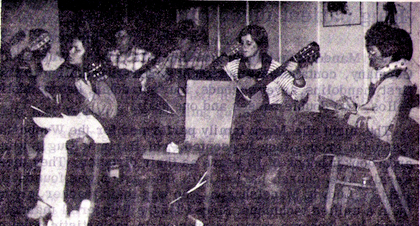 |
theWupper River, and the 11-kilometer system still carries its inhabitants. The only accident reported on the unique line was when a baby elephant fell off a car into the stream, only slightly injured.
We performed at a restaurant at the Wuppertal Zoo, known for an unusual dish of milk-rice, honey, and waffles. The audience was mostly blind, in a dinner sponsored by the city which sought to give these people unusual experiences of touch and sound. The next morning at the Wuppertal City Hall we shared two programs with a Romanian university choral group in Wuppertal on exchange. The audience was children ages 5-10, a sitzkissen konzert (children brought cushions and sat on the floor.) Adults were allowed if they accompanied a child. Klug had developed a format which we used, with good results. He and his mandolin orchestra took the initiative four years ago to start these programs for children. He explained his approach.
"I try to involve the children every time," Klug said. "It is very important that the child in the audience identifies with the artist on the stage. There must not be any difference between the artist and the audience. The artist who plays for children must have contact with the children. At nearly every concert I have some children perform. Pieces must not be long; they must show a certain glimpse of something."
He has a philosophical attitude about children: "You have to accept from children what they bring to you.. .You must never have expectations of them!'
|
||
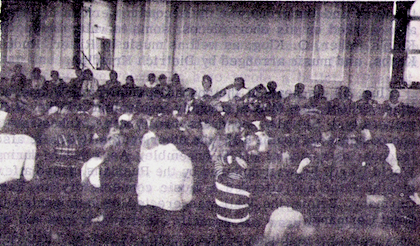 |
|||
|
When the Mock family performed in Reidenberg, Bavaria, we attended a class for mandolin players, part of the first of such workshops in Germany.
The assignment for each student was to enter the stage, perform briefly with other students acting as the audience, and leave the stage. Afterwards Siegfried Behrend and other members of the workshop staff, as well as some students, commented on the presentations.
|
|||
|
TOP---Guitar section of Mandolin-Konzertgesellshaft of Wuppertal (Ruth Mock on right taking notes), BOTTOM--Concert at Wuppertal town hail. Klug is in center with Mock family, surrounded by children sitting on floor, with adults seated on chairs.
|
|||
|
|
|||
|
8
|
9
|
||
|
|
|||
|
|
|||||
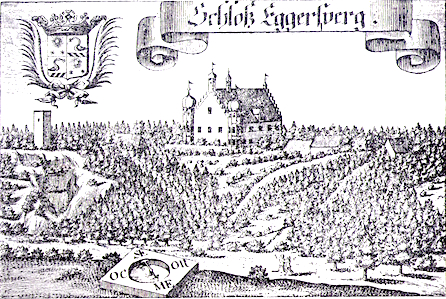 |
Three of the 10 students at the mandolin workshop were from a mandolin club at Hanover. They said the club consisted of about l50 members and had an ensemble of 40-50 members. The club meets weekly. Instruments included in the ensemble are mandolin, mandola (tuned an octave below the mandolin), guitars, and string bass. Guitarists play chords or arpeggios using fingernails and nylon strings. They said the ensemble also has two contra-bass guitars, tuned as a regular (prime) guitar but an octave below. Unfortunately we were not able to see these guitars, but Hansjoachim Kaps ordered one for his Steglitz Guitar Ensemble and has offered to give a performance report. The guitar Kaps ordered was made by Dieter Hopf, a famous guitar name in Germany. Hopf operates a guitar-making shop in Munich under the name of his father, Willi Hopf and according to Kaps personally makes the contra-guitars. We saw an octave guitar in Berlin under the Hopf label, and found it quite a good instrument (for Konrad Wölki's story about octave guitar with picture, see CGI No. 12, pp. 3-9.)
Two of the Hanover club members, Iris Hutterman and Claudia Gobrecht, obtained special permission through efforts by Behrend, to perform in the All-German Mandolin Ensemble, made up of the best mandolin players in Germany. The All-German Mandolin Ensemble performed two guitar concertos, one with Martin Kreuger as soloist the other with Michael Troster as soloist.
On Sunday, to climax the workshop of the Musikfestival im Altmuhltal, the group gave a performance at Eggersberg Castle, in ensemble. Instruments included seven mandolins, one mandola, a guitar and a string bass, which was plucked when Renaissance music was played. The guitarist played chords and some single bass notes using the thumb.
The group played a variety of music including a piece written during the workshop by composer Wolfgang Bast, Eggersberger Julistuck. As soloist, Bast played on the mandolin random chords; used a tuning fork on the strings; played in front of the fingerboard and behind it; slapped the top; and used a glass up and down the strings.
With one exception the mandolinists did not use a vibrato, and only occasionally a tremolo. The students explained
|
||||
|
SCHLOSS EGGERSBERG, castle near Riedenburg in Bavaria, overlooking valley, where ensemble performed. Also used for performances during the Musikfestival mi Altmuhltal, was Rosenburg Castle, in Riedenburg.
______________________________________________________ |
|||||
|
One student entered carrying a foot rest. Behrend later told the student to be prepared by placing the foot rest beforehand. Another student, to her embarrassment, forgot her pick. She hurriedly returned to pick it up and make another entrance, armed with the pick. Afterward, some of the students commented on the remarks made to them by the workshop members:
"They said I made no eye contact with the audience." said one.
"They said I made faces while playing," commented another.
"They said when he bowed he did not also bow his head. but kept looking at the audience," they said of another.
"They said I acted like a chambermaid on the stage and did not know what to do with myself," said yet another.
|
|||||
|
|
|||||
|
10
|
11
|
||||
|
|
|||||
|
|
|||||
|
|
|||
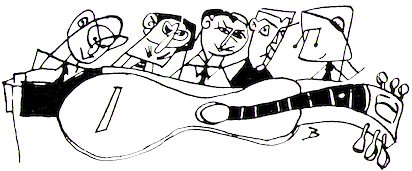 |
If someone is interested in obtaining volumes below in quantities of at least 10 copies, and cannot get it through usual sources, please contact CGI. The Alpine Regional Choir stocks 25 copies each of many of these volumes. Because it is not easy to obtain, and especially because of the fluctuation of the dollar in relation to the mark, the Alpine choir members check this music out for their use, rather than purchase it. Choir members can, and some do, order their own copies. Although Schott's music is distributed in the U. S. , apparently only part of it is available in the U. S. We would like to suggest that anyone wanting this music be aggressive with your dealer, as the music will not likely be available otherwise. Those who direct ensembles will find it to their advantage to have volumes of this music available in their libraries.
Previous CGI stories which also may be helpful are: "Guitar Ensembles," by Konrad Wölki, about the development of the guitar choir, No. 12, pp. 3-9. "Alpine Regional Guitar Choir: First in U.S.?" by Ruth Mock, No.l4, pp. 20-26.
A. Music for beginners:
Konrad Wölki, Per Gitarrenchor (The Guitar Choir), Band 1 (Volume 1), 24 pp., 17 pieces, some by Wolki some children's songs, and including a fast moving British sea chanty near the end.
Konrad Wölki, Spielstuck fur drei Gitarren (Pieces for Three Guitars), 23 pp., 11 pieces, children's songsT and music byWölki, Schott 5128.
B. Intermediate:
1. Folk music:
Hansjoachim Kaps, Folklore -Klange aus alter Welt, (Folk Sounds of the World), eight songs for three guitars or guitar choir, "52 pp., Robert Lienau, Berlin, includes folk songs and folk-like songs composed by Kaps in order of difficulty. Music folds out so there are no page turns for each song.
Konrad Wölki, Zehn deutsche VoLkstanze in Satzen fur 3 Gitarren (Ten German Folk Dances), Schott~5"419, 23 pp., includes polkas, landlers, mazurkas.
|
||
|
Drawing by Siegfried Behrend. Used with permission.
______________________________________________________ |
|||
|
that the mandolin came into disrepute because of an excess of tremolo, as well as the music being played, and so the tremolo is now used only sparingly. The group also played a new music piece by Behrend, with a guitar taking much of the melody, and mandolins using mostly pick and tremolo effects. Claudia Gobrecht and Bast performed Hermann Ambrosius' Duo fur zwie Mandolen, displaying interesting counterpoint, rhythmic problems and unusual intervals, and which would be an interesting piece for two guitars. The second movement ("Scherzo") would perhaps be aided with the sound of the guitar.
The final piece was Ambrosius' Quartett D-dur, played by the teachers, Takashi Ochi, Silvia Ochi, Bast; and Behrend on guitar.
|
|||
|
AN ANNOTATED LIST
|
|||
|
As a result of inquiries about guitar ensemble music, CGI is printing the following list of guitar choir music, all published in Germany. Other trio music exists, not intended for guitar choir music, but which usually could be played by a guitar choir. The music listed below, however, is not usually available in the U. S., but should be.
|
|||
|
12
|
|||
|
|
|||
|
|
|||
|
Konrad Wölki, PerGitarrenchor (TheGuitar Choir), Band II (Volume II), 24 pp., eight pieces from France, Sweden, etc.
HansjoachimKaps, 3 Flamencos, Robert Lienau, Berlin, score (17 pp.)andparts, three pieces, "Alegria," "Petenera gitana" and "Solea por Alegria."
Gerhard Tucholski, Sudamericana, Apollo -Verlag, 27 pp., 11 pieces, includes one solo, five duets, and the following trios suitable for guitar choir: "Jarabe Jalisco," "Jarabe Guadalajara," "El Choclo," "Tres Torres" and "Tango" by Albeniz.
2. Period music. The following series by Konrad Wölki includes transcriptions of music from the Renaissance to the romantic period:
Alte Lautenmusik (Ancient Lute Music), Edition Schott. 6389, 23 pp. , 12 pieces, music by Josquin des Prfis, Pierre Attaignant, Hans Newsidler, Francesco da Milano, etc.
Tanze und Stucke der Barockzeit (Dances and Pieces of the Baroque), Schott 5126, 23 pp. 9 pieces, music by Lully, Pratorius, Bach, Handel, etc.
Musik der Wiener Klassik (Music of Classic Vienna), Schott 5129, 23 pp., 9 pieces, Gluck, Mozart, Haydn, eta
Romantische Musik (Romantic Music), Schott ED6747, 23 pp. , 10 pieces, music by Weber, Schumann, Grieg, etc. This work is only recently published.
C. Other works for guitar choir:
Konrad Wölki, Sechs Mai Drei (Six Times Three), Josef Preissler, Munich, 23 pp., 6 pieces. This is some of Wölki"s best guitar choir music. It includes "Nostalgie" which has a guitar solo, and variations on the beautiful German folk song (not the Christmas song familiar in the U. S.) "O Tannenbaum," and including German words.
Konrad Wölki, Op. 63B: Divertimento for two octave guitars and three regular (prime) guitars (1958), Joachim Trekel, Hamburg. This is perhaps the only piece written to date for the unusual combination of guitars. Requintos can play the parts of the octave guitars. The two octave guitar
14
|
parts also could be played (with some difficulty) by regular guitars above the 12th fret. Divertimento is in five movements and includes a solo introduction.
Alfred von Beckerath, Zirkusbilder (Circus Scenes), 12miniatures, Verlag Joachim Trekel, score, 19 pp. These are delightful vignettes of circus scenes ("Herr Direktor," "The Camels," etc.), light and not difficult.
Hermann Ambrosius, Spielstuck fur drie Gitarren (Pieces for Three Guitars), score, 10 pp. , 5 pieces, Joachim Trekel, reminiscent of BartoVs children songs, light, not difficult. Included are "Unbefangen" ("Unprejudiced"), "Fughetta," "Puppentanz" ("Doll Dance"), "Bolero" and "Neckerel" ("Teasing").
Alfred von Beckerath, Munchener Gitarrentrio (Munich Guitar Trio), Joachim Trekel, score (11pp.) and parts, four movements. This is Beckerath's important guitar work, which has been recorded by the Dik Viser Trio. It is a joyous, rhythmic piece. Beckerath died in 1978. He wrote the Munich Trio for the Berlin Lautenguild, and it was performed in concert with the Lautenguild in Berlin last summer by the Mock Family Guitarists.
Hermann Ambrosius, Funf Bagatellen (Five Bagatelles), Verlag Joachim Trekel, score (12 ppT) and parts, five movements. Ambrosius, over 90, is a major composer for mandolin in Germany and has many works to his credit. His music is somewhat modern, contrapuntal and interesting. This work is for upper intermediate to advanced.
D. The following music is for guitar choir (guitar trio) and other instruments. It must all be considered upper intermediate to advanced, although none of it demands other than competent musicianship:
Dietrich Erdmann, Notturno, for flute and three guitars, Musikverlag HansGerig, Cologne, score (19 pp.) and parts . four movements. An important piece for guitar ensemble (see CGI No. 14, p. 34 for review). The Mock family performed the Notturno (with violin instead of flute) with the Madison (Wis.7~Guitar Society and the Laval University Trio during the summer of 1977.
|
||
|
|
|||
|
15
|
|||
|
|
|||
|
|
||||
|
|
||||
|
Dietrich Erdmann, Serenata Piccola (Little Serenade) for three guitars and a solo guitar, Verlag Joachim Trekel, score (11 pp.) and parts, three movements. A melodic and rhythmic piece with the solo part, accompanied by the other guitars, in the middle movement. Erdmann's is a contemporary sound in good taste.
Konrad Wölki, Gesellige Musik (Sociable Music), for three wind instruments (flute, oboe or recorder) and guitar
|
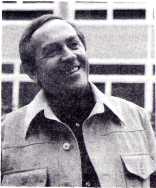 |
Georg Phillip Telemann/Konrad Wölki, Sonata in A -flat for recorder or oboe and guitar trio, Joachim Trekel.
Konrad Wölki, Musik fur schlichte Feierstunden (Music for Modest Festive Hours Op- 31 (1937), Suite No. 2 for mandolin orchestra, and two to four-voiced guitar choir, Joachim Trekel, publisher.
|
||
|
One of the most active of present day composers for the guitar is Hansjoachim Kaps of Berlin,a city full of composers.
Due for publication is a book of six compositions and arrangements for guitar choir, with accompanying record. One of the works, "Rumba Catalan," is a combination of rumba and "rumba gitana" or gypsy rumba, a flamenco style rhythm. Kaps sent a copy of "Rumba Catalan" to the Mock family, which will perform the work on their tour of the eastern U.S. and Germany in the summer of 1979.
|
||||
|
|
||||
|
choir, Joachim Trekel, score (29 pp.)and parts, four move
|
DIETRICH ERDMANN
AT BERLIN AMERIKAHAUS
|
|||
|
ments. This is probably Wölki's most ambitious work for guitar as yet, written in 1968. On his record, conducting the Berliner Lautengilde, Gesellige Musik lasts about 15 minutes and includes a guitar solo. Konrad Wölki, Heimliche Liebe (Secret Love), Op. 58, for guitars and voice, Joachim Trekel, score (9 pp.) and parts. Three short, melodic songs.
|
||||
|
Published this year is Folkloristische Suite, Preissler, Munich, 16 pp. , 12 pieces, and perhaps typical of Kaps' works. It is an example of arranging for the young student (late beginner, early intermediate), guitaristic, with arpeggios, arpeggiated triplets, use of lower strings in combination with melody on the top string, use of appropriate keys. The songs range over the fingerboard without being exceptionally difficult. Included are three songs from Britain ("Greensleeves, " "Auld Lang Syne," "Londonderry Air") as well as folk music from Sweden, Norway, Finland, Greece, Israel, Germany, Spain, and Portugal. Kaps and his wife Arnhilt teach guitar at the Steglitz music school in Berlin, which has 18 guitar teachers and 500 guitar students. Arnhilt was a student of Kaps when they met.
Also by Kaps is the recently published (1976) El Huracán (Verlag Vogt & Fritz, 872 Schweinfurt, Friedrich-Stein-Str. 10, West Germany, 6 pp., six movements) for solo guitar. Kaps has a penchant for melody and being an excellent guitarist, handles the idioms well. He had the piece in mind some years before he actually put it on paper. It describes a hurricane in complete cycle: as it approaches; arrives;
|
||||
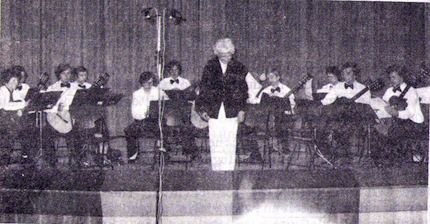 |
||||
|
GERDA WOLKI WITH BERLINER LAUTENGILDE during 1978 concert with Mock family in Berlin 16
|
||||
|
|
||||
|
17
|
||||
|
|
||||
|
|
|||
|
leaves, with its devastation; finally to the time when it is forgotten and other matters are of interest. In describing the hurricane Kaps uses repeated, tremolo-type notes; repeated chords; arpeggiated chords; a varied 3/8-2/4 time for the eye to pass over, with harmonics; and a triplet arpeggiated passage over all the strings to the climax. The piece, six and one-half minutes long, is somewhat reminiscent of Sagreras' El Colibri, in successfully depicting the concrete. It is an exciting and interesting addition to the concert repertoire. A student of Kaps, Guido Friesberg, recorded El Huracán on the record Steglitzer Gitarren Ensemble, ~Mars-Schallplatten, 1000 Berlin 31, Joachim -Friedrich-Str. 55.
Impending publication of Kaps' ensemble music follows closely on the heels of another Kaps guitar choir publication, Folklore -Klange aus aller Welt (Folk Sounds of the World), published (1974) by Robert Lieneau, Berlin, and indicates publisher confidence in expansion of guitar ensemble. Other Kaps ensemble works are due to follow. *
Folk Sounds of the World, although folk-like in sound, reflecting revived interest in folk music by Europeans, are partly original compositions and melodies. One of these pieces, "Tanz aus Thessalien" ("Greek Dance"), was performed by both Kaps' Steglitzer ensemble, and the Wedding Lautengilde of Gerda Wolki, each in joint concerts with the Mock Family Guitarists.
The Steglitz group, about 15 in number, played opening and closing pieces, including a flamenco "Farruca" composed by Kaps, which will appear with "Rumba Catalan" in his guitar choir book, to be published by Apollo Verlag. The Mock family performed before and after the intermission. We were pleasantly surprised to be called for three encores. The interest in the Mock family was unusual and in conversation at intermission, members of the audience showed insight into our goals.
After the Steglitz concert, we went to the home of our Berlin family of friends, the Schlottkes, who live only a brief walk from the Berlin Wall. We listened to U.S.
|
President Carter call Berlin "a light to the world" only an hour or so before we performed jointly with the Lautengilde. The Lautengilde also performed opening and closing numbers to a near-capacity audience at the French Center. The Lautengilde opened with two Sor numbers (Op. 1 and 11), arranged byKonrad Wölki and directed by his wife, Gerda. They also performedaTelemann Sonata with recorder, and a Beethoven Sonatine, originally for mandolin and cembalo, both arranged by Wölki. The solo part was performed on an octave guitar. After the Mock family performed, we joined the Lautengilde for a fast-moving joint performance of "Erinnerung an rumanische Dorfmusik, " Op. 88 by Wölki.
Wölki is a prolific composer who is famous in Germany for his mandolin ensemble works. However, he has written more than 10 volumes of guitar choir music.
|
||
|
Guitars adorn Berlin museum walls
|
|||
|
Of interest to musicians in Berlin is the Musikinstrumenten Museum at Bundesalle 1-12, near the center of the city.
The museum is housed in the second floor of a large building, and includes a room for performance.
Catalogs of the museum holdings, for sale in the lobby, listed only one or two of the many plucked instruments. Lutes, theorbos, baroque and classic guitars were plentiful.
Included in the collection were at least a dozen old classic guitars, several of them on the wall of a room closed to the public.
At least one six-string guitar bore a label indicating it was built in the 1700s. (I twas not possible to determine the last two numbers (17? ?) or even the maker. Like most of the guitars in the museum, it bore no inventory number in sight.
One group of six guitars was listed along with makers, all in a glass case. Five of the guitars, with maker and year are: 1. and 2. J.G. Thielman, 1810 and 1814; 3. Carl David Kursch, 1809; 4. F.A. Matthes, 1807; and 5. Charles Bachmann, 1801. All the above were made in Berlin. The sixth guitar, which stood in a corner, was made bv F.G.A.
|
|||
|
*For another story onKaps, see CGI No.15, pp. 13-14.
|
|||
|
18
|
|||
|
|
|||
|
19
|
|||
|
|
|||
|
|
|||||||
 |
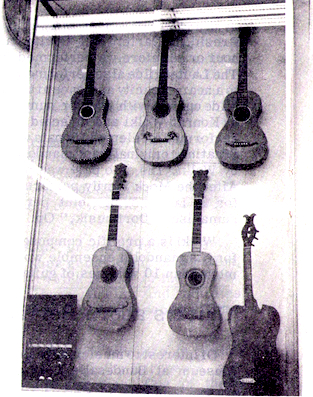 |
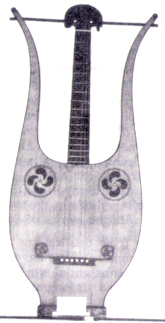 |
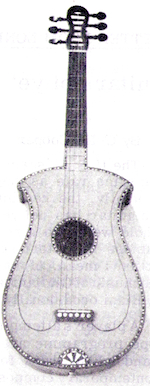 |
||||
|
|
|||||||
|
INSTRUMENTS IN MUSEUM—From left, classic guitar made in 17??; case of instruments; lyragitarre; and unlabeled instrument hanging on wall. Below shows a variety of instruments. Note Baroque guitar on bottom.
______________________________________________________________________________ |
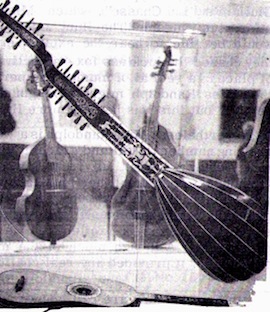 |
||||||
|
Kirst of Potsdam (near Berlin, now in on the lyragitarre. Other graphic works in East Germany), in the 18th century (ende the museum showed players of lute and 18th Jr.) guitar.
|
|||||||
|
Three other guitars were of special interest--lyragitarres made at the turn of the 19th century. The first was made by an unknown maker early in the 19th century. The second was built by Thielman around 1800, and the third by Blaise Mast in Paris in 1821. Near the instruments was an etching dated in the 1820s showing a man performing
|
Among the more interesting instruments were two six-coursed panduranen, one built by Giovani Smorsone, Rome, 1736, and the other by Domenico Brambilla, Mailand, 1768. The Smorsone instrument had 12 frets and the Brambilla instrument seven.
|
||||||
|
|
|||||||
|
|
|||
|
JOHN HOLMQUIST
|
|||
|
|
|||
|
LETTER FROM LONDON
|
Spare a sympathetic thought for the editor of a London guitar magazine who, not so long ago, stuck his neck out by proclaiming Miss X as "America's greatest guitarist", an incautious remark that was immediately snapped up by the lady's recording company. Since then we have heard Miss Y and Miss Z, excellent guitarists both. Then there is Mr. A and Mr. B, neither of whom the editor took the precaution of listening to before making his pronouncement. Now we have Mr. C, whom I have no hesitation in naming as John Holmquist, the winner of the Toronto '78 solo guitar competition. *
I found him an interesting person to talk to. He has very firm ideas about the seriousness of his chosen profession, and is likely to carry those ideas into his solo career. It is not surprising to find many contemporary composers represented in his repertoire, among them Berkeley, Smith -Brindle, McGuire and Biberian. He also plays a lot of Bach, including his own edition of the 4th Lute Suite.
John Holmquist's London debut in 1979 should be a noteworthy event.
|
||
|
By Colin Cooper
|
|||
|
The U.S.A. seem to produce good guitarists at roughly the same rate as they produce good tennis players. There, hopefully, the resemblance ends. The subtle art of playing the guitar has not yet become a spectator sport; and on the whole we go to a recital to hear good music rather than to witness the latest sensational virtuoso in action. And by action I mean, of course, the works of Sor alternating with the music of Giuliani, a boredom relieved only by the music of Giuliani occasionally alternating with the works of Sor.
A player's attempts to get away from this kind of stereotype programme are always welcome and we have Laurie Randolph to thank for playing two substantial works by the contemporary composer Abel Carlevaro. Unfortunately, these well-written and never less than interesting works sandwiched an item of the type all too common in guitar recitals--Giuliani's "La Chasse", which, Miss Randolph saw fit to inform us, meant "The Hunt". She went on to say that we would be able to hear the excited cries of the "dogs"* as they chased the luckless fox—an activity that is surely out of place in a recital of music, and perhaps everywhere else too. Miss Randolph might have got away with it in a salon recital, but this was her Wigmore Hall debut.
Nevertheless, Miss Randolph is a welcome addition to the growing number of tall and graceful young female guitarists who regularly visit us from across the Atlantic. Her technique is competent, her musicality evident in everything she attempts, her phrasing persuasive, her sense of rhythm generally impeccable. If the general atmosphere was somewhat lacking in excitement, we may fairly blame the programme. Although much of the music was unfamiliar, too little of it provided any real challenge to the listener.
|
|||
|
MIGUEL LLOBET
|
|||
|
The 100th anniversary of the birth of this brilliant and highly individual guitarist passed unnoticed in London's guitar magazine. Hardly surprising, when you recall that same journal also omitted to record John Dowland's 400th anniversary. It seems a pity: an anniversary is a good excuse for an article, if nothing else.
|
|||
|
PUBLICATIONS RECEIVED
|
|||
|
Zupfmusik -Gitarre
|
|||
|
Zupfmusik-Gitarre, EditorHeinrichMeyer, Memminger-strasse 26, 7411 Reutingen 1, West Germany.
This quarterly publication is for the Organization of German Fretted Instrument Musicians. The word guitar is
|
|||
|
|
|||
|
"For interview with Holmquist see CGI No. 16, pp.3-6.
|
|||
|
|
|||
|
KIn England they are call hounds.
|
23
|
||
|
|
|||
|
22
|
|||
|
|
|||
|
|
||||
|
added apparently to emphasize the inclusion of that instrument. The 48-page February, 1978 issue, includes articles about a fretted convention that included 11 concerts with 43 orchestras, and ensembles with 40 soloists; an article about Fernando Sor by Wolf Moser; news of performances, reviews of music, and ads of new music. It is in German.
|
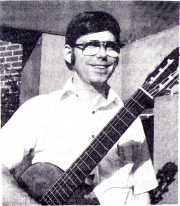 |
|||
|
Harris Herald
|
||||
|
The Harris Herald, 529 Speers Road, Oakville, Ontario, Canada L6K 2G4, No." 14 (No. 13 was published in 1971).
Issued by the Frederick Harris Music Co., Limited, a Canadian music publisher, the Herald contains an interesting bibliography of music magazines, mostly Canadian and U. S. The Herald comment on CGI: "Why does the guitar seem to produce the best magazine. This is a home spun effort of Ruth and Jerry Mock, but friendly and informative. We need more music magazines who talk to their readers like 'they wuz friends'!"
Frederick Harris also announced a new mail order department box: c/o University of Toronto Press, 33 East Tupper St., Buffalo, NY 14203.
|
||||
|
LEONARD
|
||||
|
Although most guitar teachers are relatively new to the field, Nels Leonard is an exception; a veteran of 20 years of teaching at West Liberty College, West Liberty, West Virginia, a full professor and senior member of the department.
Leonard was first a musician, then a guitarist. He came to West Liberty as a woodwind teacher and learned the guitar over the years. Like many guitarists, he learned where he could, and gradually became more involved. He learned pick guitar first, from a student who taught him in return for flute lessons. He later found a teacher in Pittsburgh, John Stodolsky (Leonard told Stodolsky he was a truck driver, so Stodolsky "wouldn't leave anything out.") Twice a week for two or three years he drove to Pittsburgh from West Liberty to take lessons from Stodolsky. He participated in master classes under Rey de la Torre, and Christopher Parkening (1973). Leonard also spent a summer in Spain, where he studied under Jose Tomas, and later Benitez Baltizar (since Leonard did not speak Spanish, he bought another student supper each night in return for his being an interpreter). The next year Leonard studied in Palma de
|
||||
|
Guitar Guild Newsletter
|
||||
|
The Guitar Guild Newsletter, 23 5 ArmingtonSt., Cranston, RI, 02905. The December meeting consisted of ensemble music, including the Rhode Island College Guitar Ensemble, the Vincent Fraioli Guitar Trio, and a quartet with two guitars, mandolin and mandocello.
|
||||
|
WHILE THEY LAST, back issues of Creative Guitar International available at $3 each. Write for free tables of contents for past issues, Vols. 1-3, Nos. 1-3; and Nos. 10 , Box 7 Alpine, TX 79830, USA.
|
||||
|
|
||||
|
25
|
||||
|
24
|
||||
|
|
||||
|
|
||||
|
|
||||
|
Mallorca under Graham Wade. Later he obtained a leave of absence from his teaching to study under Segovia at Santiago de Compostello. He also brought along his oboe and became the only participant to receive a certificate in two major areas.
Leonard also studied in England under William Grandison, whom he called a "fantastic, superb teacher."
Leonard bought guitars for his classes and the students check them out without a fee. He teaches classes in "Basic Guitar for the Classroom Teacher" and "Fundamentals of Classic Guitar. "He also gives a workshop on "Guitar in the Junior High School," as an entire music program, teaching rhythm, history, then guitar (i.e. , tunings in fourths).
"Guitar players are the worst counters in the world," Leonard said, pointing out that they are at a disadvantage in that they don't usually play in small ensembles. "They don't release and start together. .. These things are pounded into other instrumentalists."
To solve this guitarist problem, Leonard began an ensemble class with six members in 1977-78. The next year there were ten members. The class performed at the state MENC student conference at Jackson's Mills in the fall of 1978, playing music by Bach, Morley, Praetorius, Gabrielli, Handel and Wölki.
Leonard's work with the ensemble paid dividends, as the group was able to read through a great deal of ensemble music during a workshop in September 1978 conducted by Ruth Mock.
Leonard received his undergraduate degree at Marshall University, his master's at University of South Dakota, and his doctorate in music education in music theory at West Virginia University, Morgantown.
Leonard's promotion of the instrument among his students has gained him 12 guitar majors. For those who resist, he makes up finger drills and number notation. He has written the Villa-Lobos "Etude No. 1" as well as the anonymous "Romance" in tablature.
|
Leonard as a teacher and performer is as enthusiastic about guitar as he is about skiing. His next project is to add courses in guitar history and pedagogy.
|
|||
|
Improvisation: chord progression given
|
||||
|
By Ron Manzanero
|
3rd of a series
|
|||
|
Here is a simple chord progression in the key of F major to use as an accompaniment for playing scales. The student may record this progression for use as a background for playing in scale-wise motion, constant eighth notes against
|
||||
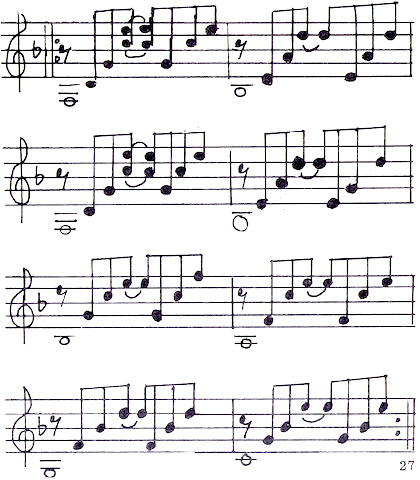 |
||||
|
26
|
||||
|
|
||||
|
|
||||
|
|
||||
|
the background. For scale patterns, see CGI No. 14, p. 6. Also one can practice the five patterns (No. 14, p. 8); linear scales (No. 15, pp. 21-22); and diagonal scales No. 16, p. 35) with the recording. The purpose of this exercise is to get used to playing through the patterns and eventually connect them all. Also, the progression can be rhythmicized to create interest and also transposed for practice in other keys. In the next article we will present some rhythmicized examples.
|
he studied violin, theory and attended lectures on music history under Schering. He also studied organ, choir conducting and composition under Prof. Siegfried Reda in 1938 and graduated from high school (German equivalent to the U.S. university) in 1939. Friedel wrote that he was in the army from February 1941 to 1945:
"Then there was not much time for music All my property was bombed." Friedel wrote.
After World War II he worked in the U. S. quartermaster depot in Munich. In 1948 he attended lectures by Prof. Dr. Mersmann, who arranged for a scholarship in composition under Prof. Wolfgang Jacobi at a music academy. He also studied at the "Studio fur Neue Musik" of Fritz Buchtger.
In 1954 Friedel moved to Berlin, where he continued his music studies under Prof. Dr. Siegfried Borris in composition, and in instrument conducting under Herbert Baumann. Friedel is a choir leader and organist.
His music plays well on the guitar and is fingered accurately for the left hand. Friedel wrote that "the basis of my compositions is the tonal order."
His list of works (most of them published) includes a wide variety of instruments: piano; choir of recorders; nine Orff instruments and harpsichord; two alto-recorders; soprano and plucked instruments-orchestra; two violins; alto recorder and piano: flute and piano; two horns; string trio; flute solo; soprano and organ; trumpet and organ; organ solo; trios for oboe; clarinet and bassoon; alto recorder and zither quartet; and soprano and alto recorder.
In addition to the above composition, Friedel has written other unpublished works for guitar: Three Pieces for Guitar; Trinitas, partita for guitar: 12 Duets for Two Guitars (dedicated to the guitar duo Claudia and Norbert Kramer);" and Spielstucke for C recorder and guitar.
Friedel also wrote this year a Quartet, for four guitars for the Mock family. The music demonstrates his rhythmic vitality, his gift for melody and his ability to compose music well balanced for ensemble. The Mock family plans to perform Friedel's Quartet on their tour of Germany during
|
|||
|
REVIEWS
|
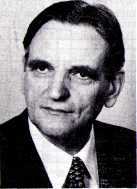 |
|||
|
for variety
|
||||
|
of instruments
|
||||
|
FRIEDEL
|
||||
|
Kurt-Joachim Friedel, Suite fur Gitarre Berben, 15 pp., 5 movements.
|
||||
|
Those who complain about a lack of solo concert pieces available perhaps have not made an extensive survey of the literature. Friedel's Suite is an excellent example of a work of sufficient length with artistic merit for a concert performance .
Friedel's music is essentially melodic and wonderfully rhythmic. He writes for a variety of instruments, including guitar ensemble.
He was born Apr. 5, 1921 in Stettin, Poland, on the border of Germany, the youngest of five children. His mother gave him his first music lessons on the piano. In 1934 Friedel received a scholarship at the Stern'sche Conservatory where
28
|
||||
|
29
|
||||
|
|
||||
|
|
|||
|
the summer of 1979. Friedel attended a Mock family performance at the French Center in Berlin during the summer of 1978. After the performance he presented a copy of his Suite to the Mock family and was asked to compose for them, which he did.
|
repertoire of works similar to Schumann's and Tchaikovsky's "Albums for the Young. " He also noted that the pieces are "unashamedly romantic." They are early intermediate pieces, in various settings, such as "Cowboy Song" with dotted rhythm in imitation of classic American cowboy songs, "A Visit to the Ballet," a bouncy dance; and the harmonic "Morning Hymn."
Bobri's short, delightful tunes include position playing, and are fingered.
|
||
|
Beginner music reviewed
|
|||
|
Stephen Paulus, Four Conversations With Guitar, Cavata Music Publishers, Inc., 941 Delaware Ave. , Mendota Hgts., MN 55118, four pieces, 5 pp.
Owen Middleton, Solo Music for Guitar, Belwin Mills, six pieces, 8 pp.
Keith R. Cole, A Guitarists Album for the Young, Ricordi, 12 pieces, 15 pp.
Vladimir Bobri, Very Easy Pieces, Franco Colombo Publications, 16 pp., 23 pieces.
All of this music is for beginners, with the possible exception of some pieces in the Cole album, and adds to the so far slim repertoire of 20th century music for beginners.
Most of it is what might be called program music, that is, music that describes the title, or vice versa. (An early classic example of program music is guitarist Hector Berlioz' Symphonie Fantastique, a work about his love for Shakespearian actress Henrietta Smithson.)
The Paulus Conversations describe four situations, "Invite," "Repartee," "Solace," and "Meander." They appropriately furnish a contrast to the standard 19th century methodbooks, and offer the student a chance to practice some skills usually left to the advanced pupilr unusual rhythm, attention to varied dynamic markings, and different and new chords and tonalities.
Middleton's Solo pieces are in a similar vein with varied rhythms ("Crazy Waltz," "Bolero," "Slow March" and "Cakewalk"), harmonies and melodies.
Cole's work is his answer to the lack in the early guitar
|
|||
|
NEW MUSIC
|
|||
|
Siegfried Behrend, Meditation for five guitars, Zimmerman, Frankfurt, includes eight-page score plus parts.
Arne Nordheim, Signals for accordion, electric guitar and percussion, score, 15 pp. , six movements; Harald Weiss, Impressionen for solo guitar, four pages; and Karl Aage Rasmussen, When I Was Happy I Wrote No Songs, seven lyrical improvisations for baritone and guitar, 9 pp., Magnamusic-Baton, Inc., 10370 Page Industrial Blvd., St. Louis, MO 63132.
Franco Donatoni, Algo, two pieces for guitar, 12 pp., Edizioni Suvini Zerboni (Boosey & Hawkes, distributor).
Barbara Kolb, Looking for Claudio, for solo guitar and tape, Boosey & Hawkes, 19 pp., one movement.
This music category, although it may include some tonal parts, also includes some unusual music setting, such as no barlines.
Behrend composed his work in Australia and dedicated it to the Mock family, which premiered it at Behrend's 1978 guitar festival at Rosenburg Castle in Riedenburg, Bavaria. In it Behrend uses such approaches as a tone row, a phrase played on a tuning fork, a phrase in which five guitarists play the guitar as a drum. Meditation may be unique as a student work of "new music" for guitar ensemble.
Although not particularly difficult, Meditation's unusual
31
|
|||
|
30
|
|||
|
|
|||
|
|
|||
|
writing requires a keen sense of timing and some improvisation, as well as different techniques (use of a tuning fork, glissandos, etc.)
Signals was recorded on Philips 854005 AY with Ingolf Olsen on guitar, and is dedicated to the Trio Mobile. It is without barlines and uses special electric guitar techniques.
In Impressionen, Weiss uses standard guitar techniques to achieve unusual effects. It is of medium difficulty.
When I Was Happy is dedicated to Ingolf Olsen and fingered by him. It also has no barlines. English words are included.
Algo is without barlines and includes 12-tone passages.
In the Kolb work, the tape accompanying the solo guitar contains mandolin, chimes, vibraphone, humming voices, and additional guitars.. The electronic tape is available from the publisher. Guitar 1 on the tape sets the new tempos for the "live" guitar.
David Starobin performed Claudio during a Carnegie Hall concert and played the guitar and mandolin on the recorded version (CRI-SD 361), reviewed by John W. Tanno, CGI No. 14, "Bream Records Feature Avant-Garde," pp. 14-18,
|
to various positions, to help the student learn the fingerboard. Excellent student beginning material.
Music for Beginners includes a'wide selection of pieces, such as lute music, Renaissance, Baroque and Classic composers, a unique approach which would tend to broaden the outlook of a student toward music other than the standard classic guitar literature. The final eight pieces apparently are contemporary works written by Hungarians.
At eight, Julian Mock enjoyed reading through the little Colour-pieces, which may illustrate what can be gained by a lack of prejudice against music with different scales and varied rhythms.
Van der Staak's studies are not particularly difficult, but since no attempt is made to show how to play them, some kind of instruction would be necessary for the student. The harmony is simple so the notes will be obvious when they are correct.
|
||
|
Miniatures retain Scottish flavor
|
|||
|
Erwin Schaller, Funf Miniaturen (Five Miniatures) after Scottish folksongs for soprano and alto recorders and guitar, editedby JurgenLibbert, Edition Preissler, 8000 Munich 1,
score and parts.
Ermanno Wolf-Ferrari, Italian Intermezzo, six pieces for flute and guitar, Mary Criswick, arranger; Josef Weinberger Ltd. , London (Boosey & Hawkes, distributor), six pieces, 22 p. , score.
Gaston Fabian, Duets for Guitar, Magnamusic-Baton,
Inc. , 22 pieces, 31 pp.
Georg Philipp Telemann (arranged by Eugene Reichenthal), First Taste of Telemann, 13 easy duets for two soprano Ides cant) or tenor recorders,Belwin Mills,13 pieces, 24 pp.
The Miniatures are delightful arrangements, retaining the Scottish flair. Thelourth contains an unusual tuning: the sixth string to F, whereby the open F gives a drone effect. Words to the songs are not included. The guitar parts are not
|
|||
|
"Jesse James" for solo guitar
|
|||
|
Gaston Fabian, Folk Tunes and Short Pieces for Guitar, Magnamusic-Baton, 59 pieces, 31pp.
Vereczkey László (editor), Guitar Music tor Beginners, 50 pieces, 31 pp; László Borsody, Colour-pieces for guitar, fingered by László Szendrey-Karper, eight pieces, 8 pp.; P. Van der Staak, Eight Studies in Harmonics, 11 pp. (Boosey & Hawkes, distributor).
The Fabian work includes short easy solo pieces, from classic composers such as Aguado, Carulli and Sor, but with more unusual folk songs (i.e., Swedish from Darlecarlia) which pose interesting problems for the beginning student. Included in the work is a clever arrangement of "Jesse James." as well as "Yankee Doodle." The pieces advance
|
|||
|
|
|||
|
32
|
33
|
||
|
|
|||
|
|
|||
|
particularly difficult, and the recorders would increase the tempos.
|
Arnold, whose Guitar Concerto, Op. 67, is performed by Bream on the other side of his record. In comparing the record with the score, it is obvious some changes have been made, in the first (allegro maestoso) and final (polonaise) movements. In both cases the music begins according to the score, and departs, most drastically in the final movement. This is not the only case of Bream being involved in changes of scores (see CGI No. 16, p. 26). Since the alterations went sometime without detection, they were obviously in keeping with the Giuliani style. Giuliani's is a virtuoso work and excellent example of the period. Chiesa's version came out of five earlier printed editions of the work. The Bream version may be heard on RCA Victor LSC -2487.
|
||
|
The Intermezzo are pleasant renditions of orchestral excerpts from three of Wolf-Ferrari's operas, Susanna's Secret, The School for Fathers, and The Jewels of the Madonna. The flute gets the melodies, the guitar, for the most part, the accompaniment, often without a great deal of variety. Each piece is printed separately on one sheet, sometimes folded twice and printed on the back, and unbound in a cardboard cover.
Duets for Guitar are Baroque and earlier music, containing good material for student reading, including well-fingered position phrases. The music lends itself well to student play, andbrings the beginner to some more advanced music in the back of the volume.
Either or both parts of the Telemann pieces could be played on guitar. In addition, guitar chords in letter form are given above the music.
|
|||
|
Rags for guitar
|
|||
|
Scott Joplin and Tom Turpin, Rags for Guitar, arranged by Michael Karp, G. Schirmer, eight pieces, 28 pp.
The collection includes "The Entertainer," is well arranged, in playable sharp keys, for the intermediate to advanced guitarist.
|
|||
|
Latin rhythms in a contemporary setting
|
|||
|
|
|||
|
Jeffrey Van, Elegy, Cavata Music Publishers, Inc., 3 pp.
This short "Homage to Manuel de Falla" puts some of the Latin rhythms and scales into a contemporary setting, with a feel of the Spanish composer. For an upper intermediate or advanced student, and requires interpretation.
|
Finnish pieces
|
||
|
Viljo Immonen (arranger), Suomalainen kitarakirja, Magnamu sic-Baton, Inc., 30 pieces, 22 pp.
Arrangements of Finnish pieces, for intermediate grades or above. The first five are folk tunes, the remainder composed pieces in the 19th century romantic tradition, including three pieces by Jean Sibelius.
|
|||
|
Altered Giuliani Concerto, unaltered
|
|||
|
|
|||
|
Mauro Giuliani, Primo Concerto in La Maggiore per chitarra e orchestra, edited by Ruggero Chiesa, Edizioni Suvini Zerboni (distributed by Boosey & Hawkes), score, 135 pp., three movements.
This is Giuliani's Concerto in A, considered the first guitar concerto written as such, and recorded in the 1960s by Julian Bream. It is also apparently the Giuliani concerto rumored in England to have been written by Malcolm
|
Sketches of Segovia
|
||
|
Andrés Segovia, Musical New Services, Ltd., 100 pp.; and Vladimir Bobri, The Segovia Technique, Collier Books, 94 pp., both in paperback, distributed by The BoldStrummer, 156 Fifth Ave. , Suite 733, NY 10010.
Andrés Segovia contains word sketches by various people
|
|||
|
35
|
|||
|
34
|
|||
|
|
|||
|
|
||||
|
about the great guitarist. It comes off as a sort of raw, unevaluated intelligence report. Some of the sketches have significance, such as Julian Bream's account of his "lessons" under the Maestro, and Gilbert Biberian's excellent appraisal of the man and his followers. In some instances poor editing has spoiled the thrust of the story. Laurie Randolph gives an account of two days spent with Segovia at a school she does not name. But we must assume it was in the U. S., since Sophoclese Papas came at the last minute from Washington. The students who perform studied under a Mr. Silva (one might assume "Mr. Silva" was Jesus Silva, guitar professor at the North Carolina School of the Arts.)
We await an authentic critical biography of Segovia. Meanwhile we must glean in bits and snatches from such as this. Fortunately there are a few highly literate passages such as the reprint of Colin Cooper's "Segovia at Oxford."
|
Guitar as a Reflex Enclosure, J Acoust Soc Am v63 n5
Le Role des Bar res de Raidissement de la Table de Resonance de la Guitare --Leur Effet Sur les Oscillations Propres du Corps de L'Instrument, Acoustica v38 n3 Sep 1977.
Acoustical Properties of Complex Cavities. Prediction and Measurements of Resonance Properties of Violin-Shaped and Guitar-Shaped Cavities, Acoustica v37 n4 May 1977 p 211-221.
Method for Adjusting the Pitch of Top and Back Plates of the Cello, Acoustica v36 n4 Dec 1976 p307-312.
Le Changement du Spectre et du Timbre de la Guitare du a la Qualite Differente du Bois de la Table de Resonance, Acoustica v33 nl Jun 1975 p25-31.
L'Analyse des Tons par L'Analyseur a Audio-Frequences pour Differentes Epaisseurs de la Table de Resonance de la Guitare, Acoustica v33 nl Jun 1975 plO-16.
Impulsive Excitation of the Resonance Boxes of Plucked Stringed Instruments, Sov Phys Acoust v20 n5 Mar-Apr 1975 p431-434.
Influence de Differents Materiaux de la Table Inferieure et du Bord Sur la Qualite du Ton de la Guitare, Acoustica v26 n6 Jun 1972 p349-352.
Making (musical instruments) with Laminated Plastics, Plast World v28 n4 Apr 1970 p29.
Vocal Responses of Mentally Retarded Subjects to Four Musical Instruments, Journal of Music Therapy 1975 Spr vl2(l) p40-43 (piano vs guitar vs pipe organ vs electronic organ.)
Effect of Contingent Guitar Lessons on Reading Behavior, Journal of Music Therapy 1974 Fal vol 11(3) pl38-146.
|
|||
|
CASSETTE REVIEW
|
||||
|
Wade records pieces
|
||||
|
Graham Wade, Guitar Miniatures, ICS Cassettes, 160 Stewarts Road, London, SW8 4UJ.
This little gem shows that pieces of medium difficulty, which can be performed by the student, can also be played well and musically. Included are the works of Pisador, Galileo Galilei, Logy, Sanz, Sor, Giuliani, Carcassi, and a Suite Miniature by Wade and a Catalan Tfolk song arranged by Wade.
|
||||
|
Computer search
|
||||
|
By Frank Wagner
|
One of a series
|
|||
|
Selective Phalangeal Tuft Fractures in a Guitar Player, Br. J. Radiology, v50, n590, pl47-148, 1977.
Fast Pitch Detection, Russell D. Hamm, Gotham Audio Corp. , New York, NY, Audio Ens Soc Prepr 58th Conv. , New York, NY, Nov. 4-7, 1977.
|
||||
|
Last Word—Guitar Strings, Chem Tech-Chemical Technology, v6, n2, pl45, 1976.
|
||||
|
|
||||
|
37
|
||||
|
|
||||
|
36
|
||||
|
|
||||
|
|
||||
|
|
||||
|
Teacher directory
|
Want ads
|
Memo
|
||
|
|
||||
|
JOSEPH GALLUCCI 165 Augusta St. Irvington, NJ 07111 Phone (201) 374-7726
|
TILLMAN HOWARD SCHAFER
45 Elm St. Bedford, MA 01730
|
TO: Librarian
SUBJECT: Guitarists
Are you furnishing your guitarist patrons with the information they need about the classic guitar ? Why not subscribe to Creative Guitar International?
|
||
|
RUTH MOCK, Alpine Regional Guitar Choir, Box X, Alpine. TX 79830
BIG NEW CATALOG OF MUSIC BY MAIL. 108 pages, $1. Jim ForestGuitar Studios, 6538 Reef ton, Cypress, CA90630.
THE PATENTED GUITAR CUSHION: First sensible alternative to the foot stool. Endorsed by Michael Lorimer, Liona Boyd and David Perry. Also--the GUITARIST'S KIT: An all suede leather kit with nail accesories and tuning fork. Write for brochure to: GUITAR WORKS (CGI), P.O. Box 65, Mt. Rainier, MD 20822.
|
||||
|
TO: Guitar teacher
SUBJECT: Your students
Are you helping your students keep up to date on what is new in classic guitar ? Why not show this issue to the person in charge of subscriptions at your school library and ask him to subscribe to Creative Guitar International
|
||||
 |
||||
|
TO: Head of Music Department SUBJECT: Your guitar department
Is your library furnishing your guitar department with the latest, most authoritative information on the classic guitar ? Why not show this issue to the person in charge of subscriptions at your school library and ask him to subscribe to Creative Guitar International
|
||||
|
Creative Guitar International is $8. 50for 3 issues. Box X, Alpine, TX 79830
|
||||
|
|
||||